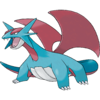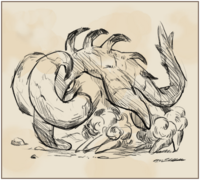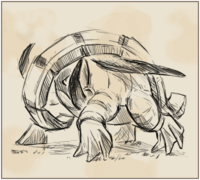|
|
| Line 415: |
Line 415: |
| * Despite all of the future Paradox Pokémon having “Iron” in their name, only {{p|Iron Treads}} and {{p|Iron Crown}} are actually {{t|Steel}} type. | | * Despite all of the future Paradox Pokémon having “Iron” in their name, only {{p|Iron Treads}} and {{p|Iron Crown}} are actually {{t|Steel}} type. |
| * In their battle against the player in Pokémon Scarlet and Violet, [[Professor Sada]]{{sup/9|S}}/[[Professor Turo]]{{sup/9|V}} uses every Paradox Pokémon present in the base game, with the exception of {{p|Great Tusk}}{{sup/9|S}}/Iron Treads{{sup/9|V}}, which is instead fought as a [[Titan Pokémon]] earlier in the story. | | * In their battle against the player in Pokémon Scarlet and Violet, [[Professor Sada]]{{sup/9|S}}/[[Professor Turo]]{{sup/9|V}} uses every Paradox Pokémon present in the base game, with the exception of {{p|Great Tusk}}{{sup/9|S}}/Iron Treads{{sup/9|V}}, which is instead fought as a [[Titan Pokémon]] earlier in the story. |
| * [[Generation II]] has the most Paradox Pokémon counterparts of Pokémon that debuted during it, at seven. Out of the [[generation]]s that have at least one, [[Generation IV]] has the fewest, at {{p|Gallade|one}}. | | * [[Generation II]] and [[Generation V]] are both tied for having the most Paradox Pokémon counterparts of Pokémon that debuted during them, at seven each. Out of the [[generation]]s that have at least one, [[Generation IV]] has the fewest, at {{p|Gallade|one}}. |
| * The Paradox Pokémon share similarities with the [[Ultra Beast]]s, another group of Pokémon. | | * The Paradox Pokémon share similarities with the [[Ultra Beast]]s, another group of Pokémon. |
| ** Both groups consist only of Pokémon that cannot evolve in the first set of games they appear in. | | ** Both groups consist only of Pokémon that cannot evolve in the first set of games they appear in. |

TCG promotional artwork of ancient Paradox Pokémon.

TCG promotional artwork of future Paradox Pokémon.
Paradox Pokémon (Japanese: パラドックスポケモン Paradox Pokémon) are a group of Pokémon introduced in Pokémon Scarlet and Violet. They have two subgroups: one appearing in Pokémon Scarlet resembling ancient relatives of contemporary Pokémon, and one appearing in Pokémon Violet resembling futuristic relatives of contemporary Pokémon. They are all gender unknown and unable to evolve or breed, and — with the exceptions of Koraidon and Miraidon — their names do not follow regular Pokémon naming conventions. All of them share the category of "Paradox Pokémon".
They are also known as unidentified creatures,[1] Monsters of Area Zero[2] (Japanese: エリアゼロの怪物 Monsters of Area Zero), and Enigmas of Paldea[3] (Japanese: パルデア未確認) by researchers and Occulture magazine articles, respectively. Professor SadaS/Professor TuroV are the head researchers on the Paradox Pokémon. The professors also refer to the Paradox Pokémon as ancient PokémonS/future PokémonV. The precise origin of the Paradox Pokémon is unclear; AI SadaS/AI TuroV claims that they originate from different points in the Pokémon world's timeline[4] (specifically the ancient pastS/distant futureV), while a SadaS/TuroV brought to the Crystal Pool by Terapagos suggests that they are from different timelines.[5] The latter explanation seems more accurate, since the original Japanese script alludes to this notion in AI SadaS/AI TuroV's dialogue.[6] They were apparently brought to Area Zero in the present day by the time machine built by the professors, but the Scarlet BookS/Violet BookV documents sightings of them prior to the time machine being built. Terapagos appears to have a connection to the Paradox Pokémon's appearance in the present day due to the Terastal energy it produces.
List of Paradox Pokémon
As a group, Paradox Pokémon share multiple similarities with one another, including a base stat total of either 570, 590, or 670, sharing Abilities related to either harsh sunlight or Electric Terrain, and having two types.
Ancient Pokémon
These Pokémon look like ancient relatives of contemporary Pokémon. They all share the Protosynthesis Ability, with the exception of Koraidon, which has Orichalcum Pulse. Their Abilities involve the effect of harsh sunlight in battle. All ancient Pokémon share a unique whistle-like sound frequency in their cries.
| Pokédex number
|
Paradox Pokémon
|
Contemporary relative
|
| Image
|
Type
|
Description
|
Image
|
Type
|
| #0984
|
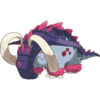
Great Tusk
|
Ground Fighting
|
Great Tusk: A Living Relic of the Dinosaur Era?!
- In one arid corner of Paldea, there have been reports of a mysterious life-form. It's said to resemble a Donphan at first glance, albeit one with gigantic tusks, tough scales, and an aggressive disposition.
- Leading theories hold that this being is nothing less than a living relic of the dinosaur era, but no one can say for sure. Apparently, it's called Great Tusk after the name of a strange being that was written about in the mysterious Scarlet Book.
Pokédex entries
- Sightings of this Pokémon have occurred in recent years. The name Great Tusk was taken from a creature listed in a certain book.
- This creature resembles a mysterious Pokémon that, according to a paranormal magazine, has lived since ancient times.
|

Donphan
|
Ground
|
| #0985
|

Scream Tail
|
Fairy Psychic
|
Scream Tail: A Billion-Year-Old Jigglypuff?!
- Somewhere in a Paldean forest, it's said, lurks Scream Tail—a being with Jigglypuff's own endearing puffball appearance but also a ferocious aggression that leads it to attack anyone who comes near.
- Its primitive appearance and savage nature have prompted rumors that it could be a Jigglypuff from one billion years ago. It's named after a creature in the Scarlet Book that is described as having a distinctive tail and scream.
Pokédex entries
- There has been only one reported sighting of this Pokémon. It resembles a mysterious creature depicted in an old expedition journal.
- It resembles a mysterious Pokémon described in a paranormal magazine as a Jigglypuff from one billion years ago.
|

Jigglypuff
|
Normal Fairy
|
| #0986
|
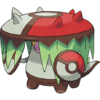
Brute Bonnet
|
Grass Dark
|
Brute Bonnet: Amoonguss Meets Dinosaur?
- This bizarre creature is said to combine traits of dinosaurs with those of the Pokémon Amoonguss. It's named after a fierce mushroom creature of matching description that appears in the renowned Scarlet Book.
- Brute Bonnet certainly resembles Amoonguss, though with its own unique twists: its gigantic stature and seemingly low intelligence combine to make it a savage, powerful fighter.
Pokédex entries
- It is possible that the creature listed as Brute Bonnet in a certain book could actually be this Pokémon.
- It bears a slight resemblance to a Pokémon described in a dubious magazine as a cross between a dinosaur and a mushroom.
|

Amoonguss
|
Grass Poison
|
| #0987
|

Flutter Mane
|
Ghost Fairy
|
Flutter Mane: A Ghostly Pterosaur?!
- Flutter Mane—a name taken from a strange creature with a matching description appearing in the Scarlet Book—is said to float around the sky at night with its long hair writhing about it.
- Eyewitness accounts describe it as resembling a giant Misdreavus at first glance, albeit a highly fierce and aggressive one. Some believe that it's a ghost of a pterosaur from a long-gone era.
Pokédex entries
- This Pokémon has characteristics similar to those of Flutter Mane, a creature mentioned in a certain book.
- It has similar features to a ghostly pterosaur that was covered in a paranormal magazine, but the two have little else in common.
|

Misdreavus
|
Ghost
|
| #0988
|
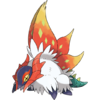
Slither Wing
|
Bug Fighting
|
Slither Wing: A Prehistoric Volcarona, Revived?!
- There have been precious few sightings reported of the ultra-mysterious Slither Wing, a being whose name is taken from that of a similar-seeming creature described in the ever-puzzling Scarlet Book.
- Slither Wing shares traits with Volcarona, so some theorize that it may have been revived from fossils from a prehistoric era that we have discussed in these pages. However, no Volcarona fossils of that era are known to have been found.
Pokédex entries
- This mysterious Pokémon has some similarities to a creature that an old book introduced as Slither Wing.
- This Pokémon somewhat resembles an ancient form of Volcarona that was introduced in a dubious magazine.
|
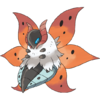
Volcarona
|
Bug Fire
|
| #0989
|

Sandy Shocks
|
Electric Ground
|
Sandy Shocks: A Magneton with a 10-Thousand-Year Lifespan?!
- Some scientists claim that this mysterious being is a Magneton that has lived for 10 thousand years. It has been sighted numerous times in Paldea's more arid regions, but there are no reports of it ever having been caught.
- It's said that Sandy Shocks is an aggressive sort and that some people who've seen it have been attacked as well. It takes its name from a beast with a matching description in the era-defining Scarlet Book.
Pokédex entries
- No records exist of this Pokémon being caught. Data is lacking, but the Pokémon’s traits match up with a creature shown in an expedition journal.
- It slightly resembles a Magneton that lived for 10,000 years and was featured in an article in a paranormal magazine.
|
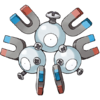
Magneton
|
Electric Steel
|
| #1005
|

Roaring Moon
|
Dragon Dark
|
Roaring Moon: A Primeval Salamence?!
- This elusive creature is called Roaring Moon after a similarly described being in the Scarlet Book. It looks similar to Salamence when they undergo a certain phenomenon elsewhere in the world, but it's unclear if there is any connection.
- This creature scatters feathers as it flies around at high speeds seeking prey. It's thought to be more savage than Salamence, and if you should encounter one, it's imperative that you avoid actual contact.
Pokédex entries
- It is possible that this is the creature listed as Roaring Moon in an expedition journal that still holds many mysteries.
- According to an article in a dubious magazine, this Pokémon has some connection to a phenomenon that occurs in a certain region.
|

Mega Salamence
|
Dragon Flying
|
| #1007
|

Koraidon
Winged King
|
Fighting Dragon
|
Pokédex entries
- This seems to be the Winged King mentioned in an old expedition journal. It was said to have split the land with its bare fists.
- This Pokémon resembles Cyclizar, but it is far burlier and more ferocious. Nothing is known about its ecology or other features.
|

Cyclizar
|
Dragon Normal
|
| #1009
|

Walking Wake
|
Water Dragon
|
Pokédex entries
- This ferocious creature is shrouded in mystery. It's named after an aquatic monster mentioned in an old expedition journal.
- It resembles an illustration published in a paranormal magazine, said to be a depiction of a super-ancient Suicune.
|

Suicune
|
Water
|
| #1020
|

Gouging Fire
|
Fire Dragon
|
Pokédex entries
- There are scant few reports of this creature being sighted. One short video shows it rampaging and spouting pillars of flame.
- It resembles an eerie Pokémon once shown in a paranormal magazine. That Pokémon was said to be an Entei regenerated from a fossil.
|
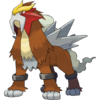
Entei
|
Fire
|
| #1021
|
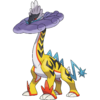
Raging Bolt
|
Electric Dragon
|
Pokédex entries
- It's said to incinerate everything around it with lightning launched from its fur. Very little is known about this creature.
- It bears resemblance to a Pokémon that became a hot topic for a short while after a paranormal magazine touted it as Raikou's ancestor.
|
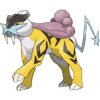
Raikou
|
Electric
|
|
|
Future Pokémon
These Pokémon look like futuristic relatives of contemporary Pokémon. They all share the Quark Drive Ability, with the exception of Miraidon, which has Hadron Engine. Their Abilities involve the effect of Electric Terrain in battle. All future Pokémon cries share a unique electronic, mechanical noise. Their names all contain the word "iron" (or the equivalent in other languages) as a prefix, with the exception of Miraidon—it, however, was formerly named "Iron Serpent".
| Pokédex number
|
Paradox Pokémon
|
Contemporary relative
|
| Image
|
Type
|
Description
|
Image
|
Type
|
| #0990
|

Iron Treads
|
Ground Steel
|
Iron Treads: An Alien Weapon?!
- In one arid corner of Paldea, there have been reports of a mysterious life-form. It's said to resemble a Donphan at first glance, albeit one that can abruptly assume a spherical shape and launch into a swift rolling attack.
- Rumors say this being is some kind of weapon using technology not of this world, but no one can say for sure. Apparently, it's called Iron Treads after the name of a strange being that was written about in the mysterious Violet Book.
Pokédex entries
- This Pokémon closely resembles a scientific weapon that a paranormal magazine claimed was sent to this planet by aliens.
- Sightings of this Pokémon have occurred in recent years. It resembles a mysterious object described in an old expedition journal.
|

Donphan
|
Ground
|
| #0991
|

Iron Bundle
|
Ice Water
|
Iron Bundle: An Ancient Civilization's Robot?!
- The mysterious Violet Book makes reference to a being called Iron Bundle, which was said to look like Delibird and to possess a spherical apparatus from which it would fire huge blasts of ice to propel itself through snowy lands.
- Plenty of theories about it have been floated. A leading one suggests it is the product of a long-gone civilization—a notion supported by ancient writings that describe the design and usage of machines resembling Iron Bundle.
Pokédex entries
- Its shape is similar to a robot featured in a paranormal magazine article. The robot was said to have been created by an ancient civilization.
- It resembles a mysterious object mentioned in an old book. There are only two reported sightings of this Pokémon.
|
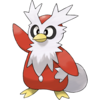
Delibird
|
Ice Flying
|
| #0992
|

Iron Hands
|
Fighting Electric
|
Iron Hands: Secretly a Cyborg?!
- This being's name comes from the one given to an iron-handed entity in the mysterious Violet Book. It is said to have fists that move independent of its body and to be capable of throwing large, fast-moving vehicles.
- A leading theory holds that Iron Hands was once an athlete who became mortally wounded but was kept alive by being made into a cyborg. Why it so strongly resembles Hariyama, however, remains unanswered.
Pokédex entries
- It is very similar to a cyborg covered exclusively by a paranormal magazine. The cyborg was said to be the modified form of a certain athlete.
- This Pokémon shares many similarities with Iron Hands, an object mentioned in a certain expedition journal.
|

Hariyama
|
Fighting
|
| #0993
|

Iron Jugulis
|
Dark Flying
|
Iron Jugulis: Pokémon or Machine?!
- This flying life-form bearing a resemblance to Hydreigon has been seen in a certain corner of Paldea. It was reported to have razed an entire building with a high-energy blast, then flown off as if to find its next objective.
- Iron Jugulis is theorized to be a sort of machine-Hydreigon hybrid, as it combines the former's ruthlessness with the latter's ferocity. It takes its name from a similarly described entity in the Violet Book.
Pokédex entries
- It resembles a certain Pokémon introduced in a paranormal magazine, described as the offspring of a Hydreigon that fell in love with a robot.
- It's possible that Iron Jugulis, an object described in an old book, may actually be this Pokémon.
|
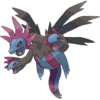
Hydreigon
|
Dark Dragon
|
| #0994
|

Iron Moth
|
Fire Poison
|
Iron Moth: A UFO Sent to Spy on Humankind?!
- The name Iron Moth was borrowed from that of a flying object described in the era-defining Violet Book. It was said to resemble Volcarona and would descend from the skies, following people around and occasionally even attacking them.
- Some point to Iron Moth's aggression as a sign that it is, in fact, a UFO of sorts being controlled by alien life. Perhaps something out there is using Iron Moth to observe us, waiting for the moment to mount an invasion...
Pokédex entries
- This Pokémon resembles an unknown object described in a paranormal magazine as a UFO sent to observe humanity.
- No records exist of this species being caught. Data is lacking, but the Pokémon's traits match up with an object described in an old book.
|

Volcarona
|
Bug Fire
|
| #0995
|

Iron Thorns
|
Rock Electric
|
Iron Thorns: A Tyranitar of the Distant Future?!
- A strange being called Iron Thorns has been sighted in a certain cave in Paldea. This being bears a strong resemblance to Tyranitar, but it apparently displays great coolheadedness and prefers to avoid unnecessary fights.
- It appears to be highly intelligent and clad in metallic armor, causing some to speculate that it may be a Tyranitar as it would appear a billion years from now. Its name comes from a similarly described entity that appears in the Violet Book.
Pokédex entries
- It has some similarities to a Pokémon introduced in a dubious magazine as a Tyranitar from one billion years into the future.
- Some of its notable features match those of an object named within a certain expedition journal as Iron Thorns.
|

Tyranitar
|
Rock Dark
|
| #1006
|

Iron Valiant
|
Fairy Fighting
|
Iron Valiant: An Experiment Gone Wrong?!
- This oddity's name is borrowed from that of an object described in the Violet Book. One theory holds that it is in fact a robot—the product of a mad scientist's efforts to create the most powerful psychic Pokémon of all.
- According to its few eyewitnesses, Iron Valiant appears similar to both Gardevoir and Gallade. It's also said to be cruel enough to take its brilliantly shining blade and cut down anyone confronting it without hesitation.
Pokédex entries
- It has some similarities to a mad scientist’s invention covered in a paranormal magazine.
- It's possible that this is the object listed as Iron Valiant in a certain expedition journal.
|

Gardevoir
|
Psychic Fairy
|
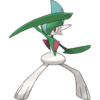
Gallade
|
Psychic Fighting
|
| #1008
|

Miraidon
Iron Serpent
|
Electric Dragon
|
Pokédex entries
- Much remains unknown about this creature. It resembles Cyclizar, but it is far more ruthless and powerful.
- This seems to be the Iron Serpent mentioned in an old book. The Iron Serpent is said to have turned the land to ash with its lightning.
|

Cyclizar
|
Dragon Normal
|
| #1010
|
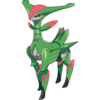
Iron Leaves
|
Grass Psychic
|
Pokédex entries
- Many of its physical characteristics match those of a Virizion from the future that was covered in a paranormal magazine.
- According to the few eyewitness accounts that exist, it used its shining blades to julienne large trees and boulders.
|

Virizion
|
Grass Fighting
|
| #1022
|

Iron Boulder
|
Rock Psychic
|
Pokédex entries
- It resembles a Pokémon described in a dubious magazine as a Terrakion that had been modified by an evil organization.
- It was named after a mysterious object recorded in an old book. Its body seems to be metallic.
|

Terrakion
|
Rock Fighting
|
| #1023
|

Iron Crown
|
Steel Psychic
|
Pokédex entries
- It resembles a mysterious object introduced in a paranormal magazine as a cutting-edge weapon shaped like a Cobalion.
- There was supposedly an incident in which it launched shining blades to cut everything around it to pieces. Little else is known about it.
|

Cobalion
|
Steel Fighting
|
|
|
In the core series games
History
Generation IX
Pokémon Scarlet and Violet
- Area Zero expedition
It is unknown where the Paradox Pokémon originate from. Conflicting accounts claim that they either come from the ancient pastS/distant futureV, or from different timelines.

Imaginary Paradox Pokémon from the Scarlet Book that resembles a fusion of the
Legendary beasts
Imaginary Paradox Pokémon from the Violet Book that resembles a fusion of the
Swords of Justice
The first recorded sightings of Paradox Pokémon were documented 200 years before the events of Pokémon Scarlet and Violet, in Area Zero within the Great Crater of Paldea located in the center of the Paldea region. A member of the Area Zero expedition team, an author and natural historian named Heath, wrote about these sightings in the Scarlet BookS/Violet BookV. Area Zero would be occupied by scientists researching the Paradox Pokémon and the Terastal phenomenon. During the expedition, a member of the team was fatally injured by a Great TuskS/Iron TreadsV that attacked them, and another survey team member managed to take a photograph of the encountered Paradox Pokémon. They at some point also encountered a KoraidonS/MiraidonV that was used in Heath's Scarlet BookS/Violet BookV's cover.
At some point, the team's sketch artist made a drawing inspired by the Paradox Pokémon they had seen, imagining what other species in the crater might look like, which resembled a combined version of the Legendary beastsS/Swords of JusticeV. Walking WakeS/Iron LeavesV, Gouging FireS/Iron BoulderV, and Raging BoltS/Iron CrownV would be later discovered, resembling the sketch, but their connection is unclear. It is unclear how these first Paradox Pokémon arrived in Paldea, but they were supposedly brought over by Terapagos due to its Terastal energy. None of these Paradox Pokémon similar to these groups are found in Paldea's Pokédex, but instead, Blueberry Academy's.
- Occulture
Eventually, a paranormal magazine called Occulture published articles on these sightings and theorized about what the Paradox Pokémon could be. At the time, the Paradox Pokémon were believed to have been fabricated by Heath, thus not being considered real. As a result, Heath and his team were widely discredited. The Paradox Pokémon faded into obscurity and research on them ended for a time.
- Project Tera
10 years before the events of Pokémon Scarlet and Violet, the Paradox Pokémon claimed to be from the ancient pastS/distant futureV were brought to Area Zero using a time machine built by Professor SadaS/Professor TuroV through Terapagos's Terastal energy. The professor is said to have used the time machine to send Poké Balls to different points in the timeline. The Poké Balls then caught the Paradox Pokémon, before bringing them into modern time. The reason the professor created the time machine was because they were fascinated with the Paradox Pokémon after reading about them from the Scarlet BookS/Violet BookV.
The professor conducted research on these Pokémon, with the ultimate goal of establishing a sanctuary in which they would be able to coexist with modern-day Pokémon. This goal would be called Project Tera. At some point, the professor created an AI version of themselves, to assist in research on Paradox Pokémon, using the very same Terastal energy that helped create the time machine. However, due to how dangerous they were to the ecosystem of Paldea, the Paradox Pokémon were kept locked away in Area Zero. At some point, security blocks and a Poké Ball Lock System were created to help both protect the time machine and Paradox Pokémon.
The player's KoraidonS/MiraidonV was the first of the Paradox Pokémon to be brought into the present; a second specimen was later brought into the present as well, but it proved to be far more aggressive than the original and drove it away in a territorial dispute. It is later revealed that the professor was killed by the second specimen while defending the first. Because of this, the Paradox Pokémon would continue to arrive in the present and eventually form their own population in Area Zero. Meanwhile, the professor's AI counterpart realized that the project was a mistake and that their creator's dreams were doomed to failure; however, their programming prevented them from doing anything that might stop the project directly.
- The Quaking Earth Titan
Later, shortly before the events of Scarlet and Violet, a lone Great TuskS/Iron TreadsV managed to escape Area Zero and become a Titan Pokémon after eating the Herba Mystica while roaming the Asado Desert. During the events of the games, the player and Arven defeat it, putting an end to its rampage.
- The Way Home
During the events of The Way Home in Scarlet and Violet, the player, Arven, Nemona, and Penny encountered several Paradox Pokémon while heading deeper into Area Zero. At Research Station 2, they encountered a wild Scream TailS/Iron BundleV, which Penny mistook for an ordinary JigglypuffS/DelibirdV until it became hostile. At Research Station 3, they encountered a wild Great TuskS/Iron TreadsV, like the one fought in the Asado Desert. Then, outside the Zero Lab, the other KoraidonS/MiraidonV was encountered before the group was ambushed by a group of Paradox Pokémon: Great Tusk, Brute Bonnet, and Flutter ManeS; or Iron Treads, Iron Hands, and Iron JugulisV. The AI professor's Paradox Protection Protocol fights the player using seven Paradox Pokémon in an attempt to defend the time machine. After a long battle, the player and their KoraidonS/MiraidonV successfully defeat the Paradox Protection Protocol and the other KoraidonS/MiraidonV. The time machine that summoned the Paradox Pokémon was then shut down when the AI professor used it one final time to travel to the ancient pastS/distant futureV.
- Post-game Paradoxes
Afterward, the rest of the Paradox Pokémon can be found in Area Zero during the post-game, including Roaring MoonS/Iron ValiantV and the second KoraidonS/MiraidonV. Walking WakeS/Iron LeavesV have only appeared in special Poké Portal News event Tera Raid Battles. Great TuskS/Iron TreadsV, Slither WingS/Iron MothV, Iron Bundle, and Flutter ManeS/Iron JugulisV have also appeared in special Tera Raids.
- The Indigo Disk
Later on after helping Perrin find the Bloodmoon Beast in The Teal Mask, she appears in the Blueberry Academy's Terarium, working there as a photographer to get promotional pictures for the academy. After the player catches 200 Pokémon in the Blueberry Pokédex and shows the player two blurry pictures, one of Gouging FireS/Iron BoulderV and one of Raging BoltS/Iron CrownV, however, she's unsure if the creatures caught in these pictures are even real to begin with. After that, the two Paradox Pokémon can be encountered in Area Zero close to where the pictures were taken, surprising Perrin that they were indeed real Pokémon.
During Briar's expedition in Area Zero Underdepths, the player encounters a Stellar Tera Sandy ShocksS/Iron ThornsV that they needed to defeat in order to open way and travel even deeper.

|
Spoilers end here.
|

|
Base stats comparison
In the anime
Main series
A Koraidon debuted in the post-episode segment of JN137, where Team Rocket tried to catch it but failed and were rammed by it, sending them flying away.
A Miraidon debuted in the post-episode segment of JN138, where Team Rocket tried to catch it as well, but failed again and were shocked and sent flying away by it.
Biri-Biri
A Great Tusk, namely the Quaking Earth Titan, briefly appeared as a silhouette in the music video for Biri-Biri.
In the manga
Miraidon debuted as Violet's ride Pokémon. He later revealed to Arven that he had encountered it on a beach at Poco Path, after which Professor Turo had contracted him and asked him to take care of it.
Later in the arc, Violet and Arven visited Asado Desert and encountered two Paradox Pokémon; the Quaking Earth Titan; Iron Treads and Great Tusk. Being outmatched against them, they were ultimately forced to retreat.
In the TCG
- Main articles: Ancient (TCG); Future (TCG)

An example of an Ancient Pokémon card

An example of a Future Pokémon card
The Paradox Pokémon Great Tusk, Iron Treads, Koraidon, and Miraidon appear in the Pokémon Trading Card Game starting with the Scarlet & Violet expansion (the Japanese Scarlet ex and Violet ex expansions) as Pokémon ex cards. Non-Pokémon ex versions of Koraidon and Miraidon were also released in the same expansion.
Starting with the Paradox Rift expansion (the Japanese Ancient Roar and Future Flash expansions), two new categories of cards were introduced: Ancient and Future, which includes all cards of Paradox Pokémon released in this set. Ancient Pokémon cards tend to have direct attacks that deal a large amount of damage, while being difficult to Knock Out. Future Pokémon cards tend to have Abilities and attacks with extra effects, allowing for craftier strategies.
Trivia
- Donphan, Volcarona, and Cyclizar are the only Pokémon to have both ancient and future Paradox Pokémon counterparts.
- All three of these Pokémon have Fighting-type ancient counterparts.
- Iron Valiant is the only Paradox Pokémon to be based on more than one Pokémon.
- Roaring Moon, Iron Jugulis, and Iron Thorns are the only Paradox Pokémon to have a lower base stat total than their contemporary counterparts (all of which are pseudo-legendary Pokémon).
- The ancient Pokémon, Flutter Mane, Scream Tail and Sandy Shocks are the only Paradox Pokémon whose contemporary relatives are not fully evolved. Furthermore, these contemporary Pokémon all evolve with Evolution stones.
- No Paradox Pokémon based on a version-exclusive Pokémon is available in the same version as its present-day counterpart in Pokémon Scarlet and Violet, except for the post-release Paradox Pokémon based on Legendary trios; for example, both Raikou and Raging Bolt are exclusive to Pokémon Scarlet.
- All Paradox Pokémon are dual-type.
- All Paradox Pokémon share one of their types with their apparent relatives and have another type that the relative lacks.
- There is at least one Paradox Pokémon of every type except Normal.
- Dragon is the most common types for Paradox Pokémon to have, with six Paradox Pokémon having it.
- Miraidon and Raging Bolt are the only Paradox Pokémon to share both of their types with each other.
- The naming convention for Paradox Pokémon differs by language:
- In Japanese, Spanish, Italian, and German, along with all East Asian translations, Paradox Pokémon are named with a single word.
- In English, Paradox Pokémon are named with a two-word descriptor; all future Paradox Pokémon have "Iron" as the first word in their names.
- In French, Paradox Pokémon are named with two or three words hyphenated into a single name; all future Paradox Pokémon have the suffix "-de-Fer" in their names.
- All ancient Pokémon are taller than the Pokémon they are based on, while all future Pokémon except Miraidon are shorter.
- Furthermore, all ancient Pokémon weigh more than the Pokémon they are based on except Sandy Shocks, which weighs the same as Magneton.
- Raging Bolt and Gouging Fire are the only ancient Paradox Pokémon that do not have yellow eyes.
- Despite all of the future Paradox Pokémon having “Iron” in their name, only Iron Treads and Iron Crown are actually Steel type.
- In their battle against the player in Pokémon Scarlet and Violet, Professor SadaS/Professor TuroV uses every Paradox Pokémon present in the base game, with the exception of Great TuskS/Iron TreadsV, which is instead fought as a Titan Pokémon earlier in the story.
- Generation II and Generation V are both tied for having the most Paradox Pokémon counterparts of Pokémon that debuted during them, at seven each. Out of the generations that have at least one, Generation IV has the fewest, at one.
- The Paradox Pokémon share similarities with the Ultra Beasts, another group of Pokémon.
- Both groups consist only of Pokémon that cannot evolve in the first set of games they appear in.
- Both play a role in the main story of their debut games.
- Both groups consist entirely of gender unknown Pokémon in the No Eggs Discovered Egg Group, thus being unable to breed.
- Both are connected to the mascot Legendary Pokémon of the games they were introduced in.
- Both have base stats themed around a certain type of number, with the ancient Pokémon having odd-numbered base stats and all future Pokémon have even-numbered base stats, while Ultra Beasts have base stats themed around prime numbers. Additionally, the levels they learn moves at are themed around numbers, with Paradox Pokémon learning moves around multiples of seven, while Ultra Beasts learn moves around prime numbers.
- The majority of Pokémon in both groups have a base stat total of 570.
- Every Ultra Beast and Paradox Pokémon (except Koraidon and Miraidon) has an Ability that boosts its most proficient non-HP stat.
- Promotional material for both groups' debut games did not refer to them as Pokémon or reveal any of their types prior to the games' releases.
- Characters in the games are initially unsure whether the members of either group are actually Pokémon.
- With the exception of Koraidon and Miraidon, all three groups have a certain sound sample found in their cries
- The term "Paradox Pokémon" may be a reference to Animalia Paradoxa.
- The Paradox Pokémon (excluding Koraidon and Miraidon) and Type: Null are the only Pokémon to have Spanish and Italian names different to their English names.
- All Paradox Pokémon's Pokédex entries in the versions they are not obtainable in reference Occulture, except Koraidon and Miraidon.
In other languages
Paradox Pokémon
References
See also






























































